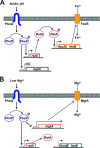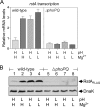Activated by different signals, the PhoP/PhoQ two-component system differentially regulates metal uptake
- PMID: 19801407
- PMCID: PMC2786564
- DOI: 10.1128/JB.00958-09
Activated by different signals, the PhoP/PhoQ two-component system differentially regulates metal uptake
Abstract
The PhoP/PhoQ two-component system controls several physiological and virulence functions in Salmonella enterica. This system is activated by low Mg(2+), acidic pH, and antimicrobial peptides, but the biological consequences resulting from sensing multiple signals are presently unclear. Here, we report that the PhoP/PhoQ system regulates different Salmonella genes depending on whether the inducing signal is acidic pH or low Mg(2+). When Salmonella experiences acidic pH, the PhoP/PhoQ system promotes Fe(2+) uptake in a process that requires the response regulator RstA, activating transcription of the Fe(2+) transporter gene feoB. In contrast, the PhoP-induced RstA protein did not promote feoB expression at neutral pH with low Mg(2+). The PhoP/PhoQ system promotes the expression of the Mg(2+) transporter mgtA gene only when activated in bacteria starved for Mg(2+). This is because mgtA transcription promoted at high Mg(2+) concentrations by the acidic-pH-activated PhoP protein failed to reach the mgtA coding region due to the mgtA leader region functioning as a Mg(2+) sensor. Our results show that a single two-component regulatory system can regulate distinct sets of genes in response to different input signals.
Figures







References
-
- Andrews, S. C., A. K. Robinson, and F. Rodriguez-Quinones. 2003. Bacterial iron homeostasis. FEMS Microbiol. Rev. 27:215-237. - PubMed
-
- Bader, M. W., S. Sanowar, M. E. Daley, A. R. Schneider, U. Cho, W. Xu, R. E. Klevit, H. Le Moual, and S. I. Miller. 2005. Recognition of antimicrobial peptides by a bacterial sensor kinase. Cell 122:461-472. - PubMed
Publication types
MeSH terms
Substances
Grants and funding
LinkOut - more resources
Full Text Sources
Molecular Biology Databases

